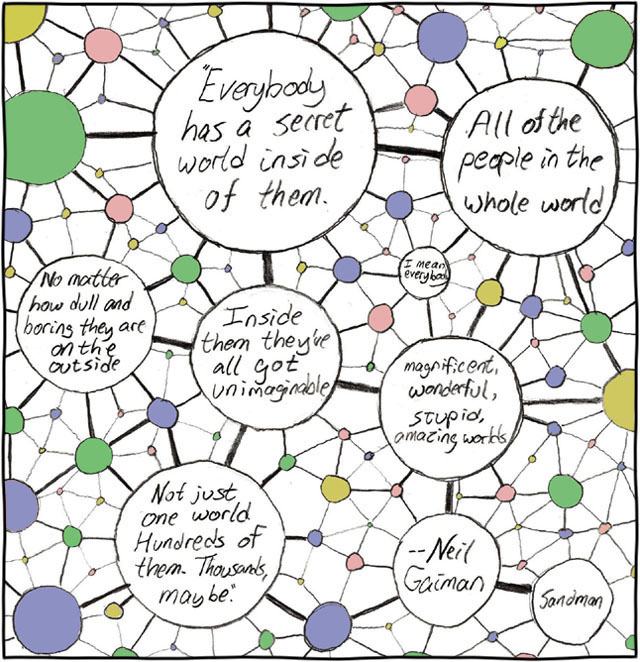52: Secret Worlds
| Secret Worlds |
 Title text: No two adjacent circles are the same color. |
Explanation
The quote written in the large white bubbles comes from The Sandman, a comic book series about dreams. Neil Gaiman is a science fiction and fantasy author who came to fame for writing The Sandman.
The interconnected bubbles represent the secret worlds of different people and how they are connected. They may have the second meaning of the neurons in our brain.
The title text indicates that Randall used the Four color theorem, which states that a graph drawn on a flat plane (like this one) requires at most four colors so that each region differs from all of its neighbors. The comic uses four colors (red, yellow, green, blue). This clearly does not include the white bubbles with text.
Here is the quote, to those wondering how to read the comic:
- “Everybody has a secret world inside of them... All of the people in the whole world, I mean everybody — no matter how dull and boring they are on the outside. Inside them they've all got unimaginable, magnificent, wonderful, stupid, amazing worlds... Not just one world. Hundreds of them. Thousands, maybe.”
Transcript
- [A multitude of circles connected with several lines. Most of them are rather small and colored red, yellow, green and blue. Nine of them are white, six of these are larger than all the other circles, but one is the same size as the largest colored (green) circle, and the two smallest are smaller than a few of the colored circles. Pieces of text are written in all the white circles. Although it can be confusing at first, the reading order is still the normal one: left to right and top to bottom. Reading the circles in that order gives the following text:]
- "Everybody has a secret world inside of them.
- All of the people in the whole world
- I mean everybody
- No matter how dull and boring they are on the outside
- Inside they've all got unimaginable
- magnificent, wonderful, stupid, amazing, worlds
- Not just one world. Hundreds of them. Thousands, maybe."
- --Neil Gaiman
- Sandman
Trivia
- This was the fiftieth comic originally posted to LiveJournal. The previous one was 51: Malaria, and the next one was 53: Hobby.
- This comic was one of the last 11 comics posted on LiveJournal.
- These 11 comics were posted both on LiveJournal and xkcd after the xkcd site opened on the 1st of January 2006.
- The first six comics were posted on both sites on the same day. But not this one.
- For some reason, 54: Science was posted before this one on LiveJournal on the 18th of January 2006, but first a week later on xkcd on the 25th of January 2006.
- 52: Secret Worlds was then released on xkcd the same day as 51: Malaria came out on LiveJournal on Saturday the 21st of January 2006.
- It then came out on LiveJournal two days later on Monday the 23rd of January 2006.
- The release date here on explain xkcd uses the first release date, so that is the one on xkcd.
- After the mishap with 54: Science, the next three comics came out on LiveJournal a release day later.
- First with the last comic released on LiveJournal, 55: Useless, did the two sites release the same comic on the same day again.
- During the start-up of xkcd, several of the comics were released on days that deviated from the normal Monday, Wednesday, Friday scheme. This one was released on a Saturday. Since it was first posted on xkcd, there is no time given for the post. But 51: Malaria was posted so early on Saturday, 1:43 am, that it could almost have been a Friday comic. It is likely that these two were posted close to each other. The previous "Friday" comic, 49: Want, was also released on a Saturday.
Discussion
Just to the left of the small circle that says something like "I mean everybody!" are two adjacent yellow circles. 199.27.128.109 (talk) (please sign your comments with ~~~~)
- Nope. Red and yellow. Zoom in and you'll see it. 108.162.242.5 04:13, 30 November 2014 (UTC)
The graph does indeed require four colors, since it contains four mutually connected circles in the upper left corner. Richmond tudor (talk) 04:52, 13 March 2015 (UTC)
